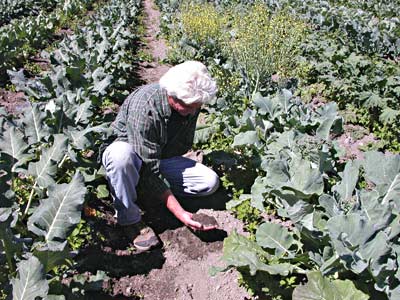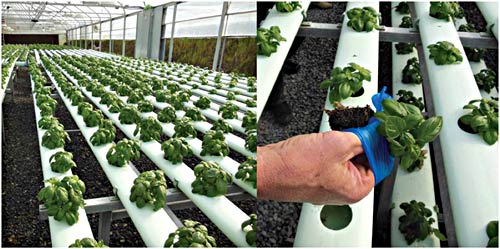 |
| Many organic growers and consumers believe that organic cultivation must take place in soil. Here the author, Eric Sideman, appreciates the soil on an organic farm. Becky Sideman photo |
 |
| The USDA National Organic Program has asked the National Organic Standards Board for advice about whether or not hydroponically grown crops raised with natural materials may be labeled as organic. John Biernbaum photo |
By Eric Sideman, Ph.D.
Updated March 18, 2020
Organic growing was defined by J. I. Rodale and his staff as a system whereby a fertile soil is maintained by applying nature’s own law of replenishing it – that is, by adding organic matter to preserve humus rather than using chemical fertilizers. (Rodale, J.I., et al., “The Encyclopedia of Organic Gardening,” 1971)
Hydroponic growing is producing crops in nutrient-rich solutions or in an inert, porous, solid matrix bathed in nutrient-rich solutions. Should crops grown hydroponically be allowed to be called “organic” if those nutrient-rich solutions are derived from natural materials rather than from chemical fertilizers? Equally important, who says whether they can or cannot be called organic?
In 1990 Congress passed the Organic Foods Production Act (OFPA), and in 2000 the USDA National Organic Program (NOP) produced the final Rule that regulates and enforces the OFPA. The USDA now has the legal authority to say what is or is not organic, based on the OFPA and the NOP Rule. But NOP regulations do not address hydroponic production. When they and OFPA were written, the authors seem to have simply assumed that organic production would occur in the soil. Because no language specifically prohibits or allows hydroponic production, some organic certification agencies have certified hydroponic production as organic (if it is based on natural materials). And many of these crops are filling a good chunk of the organic produce section at major retailers. These crops are not labeled as having been raised hydroponically.
Most U.S. organic certifiers, including MOFGA, have decided not to certify any hydroponic production as organic because we believe that much of the general NOP regulations disallow organic production outside of a soil. The NOP views this inconsistency among certifiers as a serious problem and asked the National Organic Standards Board (NOSB, an advisory board to the USDA) for advice. Even though the NOSB submitted a recommendation on the matter to the NOP in 2010, the NOP feels some areas still need clarification before it can make a decision and write a new rule. So the NOP and NOSB created The Hydroponic and Aquaponic Task Force. (Aquaponics is a type of hydroponics in which fish are raised, and their waste becomes the source of nutrients for plants growing hydroponically.) The mission of the task force was to gather background information and report to the NOSB so that it could add to its 2010 recommendation, which had concluded that hydroponic production should not be labeled organic.
I was appointed to and served on that task force, and we submitted our report to the NOSB for consideration at its meeting this October 2016 in Washington, D.C.
The task force was made up of representatives from organic certifiers, crop scientists, organic producers, hydroponic producers, hydroponic scientists and aquaponic producers. Strong opinions quickly divided the task force into two subcommittees, which submitted two separate reports to the NOSB, posted at https://www.ams.usda.gov/sites/default/files/media/2016-Hydroponic-Task-Force-Report.PDF.
Our subcommittee concluded that organic production should take place in soil. The crux of our conclusion is the distinction between organic and conventional fertility management. In organic management, the bulk of the crop nutrients come from the biological activity decomposing complex organic molecules (compost, manures, seed meals, etc.) and the mineral fractions in the soil. In contrast, in nonorganic production, the bulk of the crop nutrients are supplied as synthetic chemicals in available forms. Soil management is at the heart of organic production, while fertilizer management is the basis of nonorganic systems.
We based our conclusion on the history of the organic farming movement, which began in the early part of the 20th century, pioneered by farmers and academics who were responding to obvious problems with “modern” agriculture, such as soil erosion, depletion of soil fertility and structure, decline of livestock health caused by feed lacking quality, etc. The pioneers (Sir Albert Howard, Lady Eve Balfour, Rudolf Steiner, Jerome Irving Rodale, Aldo Leopold, William Albrecht and others) fostered the notion that the success and sustainability of farming relies on managing soil health. Most at that time referred to this as humus farming. They recognized that the soil is a complex system of countless biological interactions and that ordinary practices of crop production weaken these interactions and lead to loss of soil fertility and health. The kingpin of what they termed “humus farming” – named after the very stable organic matter at the heart of healthy soil and later to be called “organic farming” – is that in order to maintain and increase productivity, the soil needs to be restored continuously by “manuring,” managing crop residue, composting, cover cropping and adding natural rock powders.
During the 1960s the counterculture began to link the organic agriculture movement with the wider environmental movement, and it gained increasing recognition among the general public. The new generation of farmers that arose from what is now termed the “back-to-the-land” movement played a role in this growing recognition. These farmers marketed their products at farmers’ markets, from their own farm stands and to the growing number of health food stores. As demand grew for organic food, and farmers began bringing food from their communities to health food stores in the cities, the distance between the producer and the customer grew. Third-party certification emerged as a way to assure customers, now far removed from their farmers, that the products they purchased were truly organic.
In 1971 Organic Farming and Gardening Magazine, published by Rodale Press, initiated an organic certification program based upon standards developing at that time in Europe. In 1972 MOFGA ran its first organic certification program based on the Rodale Organic Certification Program. California Certified Organic Farmers followed in 1973. Many more certifiers organized during the next decade, and by the 1980s farmers across the country could find an organic certifier close to home. Although minor variations existed in allowed practices and materials, the standards used by each certifier were remarkably similar. Farmers had to submit a plan to the certifier that detailed what practices and materials were used on the farm to produce the crops to be called organic. Of course organic standards did not allow most synthetic pesticides and fertilizers; the real crux of the standards, however, was not what was prohibited but what was required. Organic certification standards required on-farm practices and use of materials that fostered soil health by managing crop residue, using livestock manures, composting, cover cropping and adding natural rock powders. In other words, these early organic certification programs reflected the farming practices suggested by the pioneers of organic farming.
OFPA, the USDA Organic Regulations and the NOSB
Those same farming practices were later reflected in the federal regulations. Writing the OFPA was a grassroots effort. Although not everyone involved with the organic movement in the 1980s supported the idea of a federal regulation, those writing the regulation made a tremendous effort to include representatives from organic certifiers from coast to coast. As a result OFPA represents the standards that guided organic production before its passage. And the NOP did a good job of carrying this over when it wrote the regulatory text that implements the law, especially the sections on managing the soil. Both OFPA and the USDA organic regulations were written with the understanding that the foundation of organic farming is soil management.
In November 2017 the NOSB met and failed to get enough votes to prohibit organic certification of hydroponic operations.
In March 2020 the Center for Food Safety (CFS), a number of organic farmers and MOFGA sued the USDA for certifying some hydroponic produce as organic after after the USDA rejected their 2019 petition to exclude such operations from organic certification. Let’s hope the lawsuit succeeds and stresses to the NOP that organic farming is based on managing the soil, and that although some hydroponic production may be environmentally friendly, may produce healthful food and generally is good, it can never be organic.
Eric is MOFGA’s organic crop specialist emeritus. You can contact him at 207-568-4142 or [email protected].
